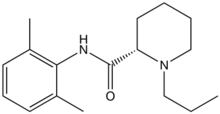- Ropivacaine
-
Ropivacaine 
Systematic (IUPAC) name (S)-N-(2,6-dimethylphenyl)-
1-propylpiperidine-2-carboxamideClinical data AHFS/Drugs.com Consumer Drug Information Pregnancy cat. B1(AU) Legal status Prescription Only (S4) (AU) Routes Parenteral Pharmacokinetic data Bioavailability 87%–98% (epidural) Metabolism Hepatic (CYP1A2-mediated) Half-life 1.6–6 hours (varies with administration route) Excretion Renal 86% Identifiers CAS number 84057-95-4 
ATC code N01BB09 PubChem CID 175805 DrugBank APRD00492 ChemSpider 153165 
UNII 7IO5LYA57N 
KEGG D08490 
ChEBI CHEBI:8890 
ChEMBL CHEMBL1077896 
Chemical data Formula C17H26N2O Mol. mass 274.4 g/mol SMILES eMolecules & PubChem  (what is this?) (verify)
(what is this?) (verify)Ropivacaine (rINN) (
 /roʊˈpɪvəkeɪn/) is a local anaesthetic drug belonging to the amino amide group. The name ropivacaine refers to both the racemate and the marketed S-enantiomer. Ropivacaine hydrochloride is commonly marketed by AstraZeneca under the trade name Naropin.
/roʊˈpɪvəkeɪn/) is a local anaesthetic drug belonging to the amino amide group. The name ropivacaine refers to both the racemate and the marketed S-enantiomer. Ropivacaine hydrochloride is commonly marketed by AstraZeneca under the trade name Naropin.Contents
History
Ropivacaine was developed after bupivacaine was noted to be associated with cardiac arrest, particularly in pregnant women. Ropivacaine was found to have less cardiotoxicity than bupivacaine in animal models.
Clinical use
Indications
Ropivacaine is indicated for local anaesthesia including infiltration, nerve block, epidural and intrathecal anaesthesia in adults and children over 12 years. It is also indicated for peripheral nerve block and caudal epidural in children 1–12 years for surgical pain. It is also sometimes used for infiltration anaesthesia for surgical pain in children.
Ropivacaine is often co-administered with fentanyl for epidural analgesia, for example in pregnant women during labour.
Contraindications
Ropivacaine is contraindicated for IV regional anaesthesia (IVRA). However, new data suggested that both Ropivacaine (1.2-1.8mg/kg in 40ml) and levobupivacaine (40ml of 0.125% solution) can be used, because they have less cardiovascular and central nervous system toxicity than racemic bupivacaine (Basic of Anesthesia, Robert Stoelting, page 289).
Adverse effects
Adverse drug reactions (ADRs) are rare when it is administered correctly. Most ADRs relate to administration technique (resulting in systemic exposure) or pharmacological effects of anesthesia, however allergic reactions can rarely occur.
Systemic exposure to excessive quantities of ropivacaine mainly result in central nervous system (CNS) and cardiovascular effects – CNS effects usually occur at lower blood plasma concentrations and additional cardiovascular effects present at higher concentrations, though cardiovascular collapse may also occur with low concentrations. CNS effects may include CNS excitation (nervousness, tingling around the mouth, tinnitus, tremor, dizziness, blurred vision, seizures) followed by depression (drowsiness, loss of consciousness, respiratory depression and apnea). Cardiovascular effects include hypotension, bradycardia, arrhythmias, and/or cardiac arrest – some of which may be due to hypoxemia secondary to respiratory depression.[1]
Treatment of overdose: "Lipid rescue"
As for bupivacaine, there is evidence that Intralipid, a commonly available intravenous lipid emulsion, can be effective in treating severe cardiotoxicity secondary to local anaesthetic overdose in animal experiments[2] and in humans.[3][4][5]
References
- ^ Rossi S, editor. Australian Medicines Handbook 2006. Adelaide: Australian Medicines Handbook; 2006. ISBN 0-9757919-2-3
- ^ Weinberg, G, Ripper, R, Feinstein, DL, Hoffman W. Lipid emulsion infusion rescues dogs from bupivacaine-induced cardiac toxicity. Reg Anesth Pain Med 2003;28:198-202. doi:10.1053/rapm.2003.50041 PMID 12772136
- ^ Picard J, Meek T. Lipid emulsion to treat overdose of local anaesthetic: the gift of the glob. Anaesthesia 2006;61:107-9. doi:10.1111/j.1365-2044.2005.04494.x PMID 16430560
- ^ Rosenblatt MA, Abel M, Fischer GW, Itzkovich CJ, Eisenkraft JB. Successful Use of a 20% lipid emulsion to resuscitate a patient after a presumed bupivacaine-related cardiac arrest. Anesthesiology 2006;105:217-8. doi:10.1097/00000542-200607000-00033 PMID 16810015
- ^ Litz, RJ, Popp M, Stehr S N, Koch T. Successful resuscitation of a patient with ropivacaine-induced asystole after axillary plexus block using lipid infusion. Anaesthesia 2006;61:800-1.
External links
- European Society of Anaesthesiologists: Use of ropivacaine in clinical practice
- More on lipid rescue
Anesthetics: Local anesthetics - primarily sodium channel blockers (N01B) Esters Esters of aminobenzoic acidAmylocaine • Benzocaine • Butacaine • Butamben • Chloroprocaine • Dimethocaine • Meprylcaine • Metabutoxycaine • Orthocaine • Propoxycaine • Procaine (Novocaine) • Proxymetacaine • Risocaine • TetracaineEsters of benzoic acidAmides Articaine • Bupivacaine # /Levobupivacaine/Ropivacaine • Carticaine • Cinchocaine • Etidocaine • Lidocaine # • Mepivacaine • Prilocaine • TrimecaineCombinations Categories:- Local anesthetics
- Obstetrics
- Piperidines
- Anilides
Wikimedia Foundation. 2010.
